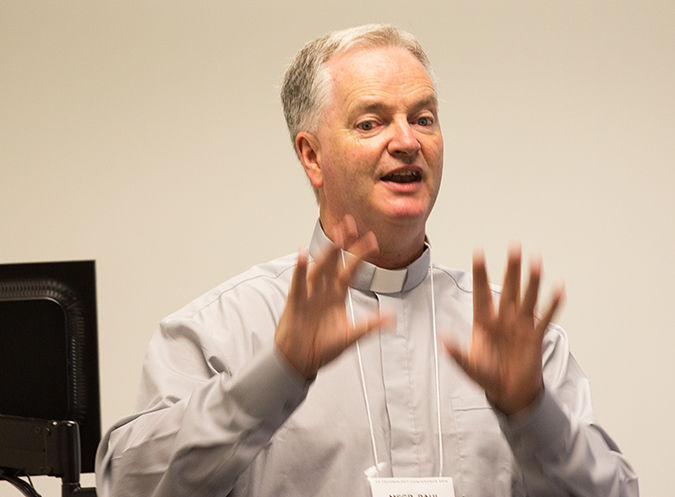Spreading the Gospel — especially for Christians in the last century — often meant traveling to foreign lands, meeting the people, learning the language and then putting into those words (and maybe images) the message of the church.
That chain of events is identical for church leaders today who are looking to bring the message of Jesus to the masses in this highly sophisticated, and often overwhelming, digital age.
Principals, teachers, clergy and staff from more than 125 parishes and school in the Los Angeles Archdiocese attended a discussion on integrating technology and understanding the digital landscape by Msgr. Paul Tighe, Secretary to the Pontifical Council for Social Communications of the Vatican. The Aug. 13 lecture was held in conjunction with the third annual Catholic Communication Collaboration (C3) Technology Conference at Loyola Marymount University.
Msgr. Tighe’s talk encouraged participants to embrace the technology of the day and to see how social media can be a journey for spiritual transformation as well as the impetus of community and support.
“This small device that I can fit in my hand is revolutionary and it does things we couldn’t imagine 20-30 years ago,” he said, adding that the rules of communication have drastically changed from when he was young. “My nieces and nephews are getting news differently from me, they are forming relationships differently from me, they are learning differently from me. When I was a teacher, I was the gate keeper on what my students read; now a teacher’s role is more of a mentor and a guide.”
Those two roles are what the church needs to be in the various social media platforms.
Rather than dismissing the digital world as somehow “unreal,” church leaders need to see the connections that networking can have on the physical world. What we see online can enhance, enlighten and can deepen our appreciation and connection to the physical world.
Msgr. Tighe stressed that while social media can have many negative followers — trolls and haters — who use the platform to manipulate and unfairly criticize, that’s no excuse for dismissing it.
“Our job is to change that atmosphere and it’s not going to be easy,” he said, describing how after Pope Benedict starting using Twitter in 2012 he would receive plenty of negative comments. “We need to stand by our values, be open and honest and allow for objectivity. Social media debaters can be emotional and we have to be that calm and reasonable voice. Dialogue begins with listening.”
To illustrate his point, Msgr. Tighe referred to Pope Francis’ claim of “Who is my neighbor in social media?” “We have to reject the culture of rejection and manipulation that’s so prevalent in society and off images of hope and support by imitating the Good Samaritan in the digital world.”
Much of the language of the digital age involves images, and Msgr. Tighe encouraged participate to always “show rather than tell” by using photos, art, videos and pictures to tell the story.
“Gone are the days where you can just slap up your newsletter or podcast online,” he said. “You have to engage your readers — do what you can, and allow for mistakes.”
Don’t get tied to just using one type of social media, advised Msgr. Tighe. After all, who knows if that platform will be around in the coming years? Be flexible, take risks and learn from younger people.
Above all, don’t forget the parable of the mustard seed. Parishes may have created a great short video with an important message and only get 200 views. “Then someone else puts up a cat video and that gets 2 million hits,” he says. “Remember, everything starts out small. Don’t give up and keep growing.”

